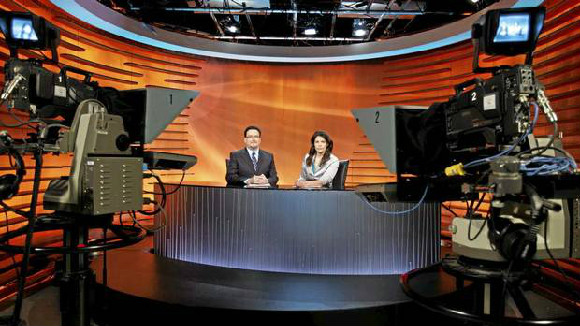Welcome to Indigenous Futures in Engineering, Queen's University
Search
Indigenous Broadcasting
Types of Engineering involved: Communications
Broadcasting uses communication technologies to send one television or radio signal to a lot of people at the same time. About twenty years ago, the only television shows people could get in the North were filmed and produced in the south. These shows might have been entertaining, but they certainly didn't represent what life is really like for people living in northern Indigenous communities. So, over time, a number of local, Indigenous communications societies began producing programming "of social, cultural and linguistic importance to their own peoples." The first of these was Inuit Broadcasting (IBC) in the eastern Arctic, which was established in the early 1980s. Television Northern Canada (TVNC) was formed in 1991 when IBC and a number of other societies, like Inuvialuit Communications Society and Northern Native Broadcasting, joined together. They formed a pan-Northern broadcaster which serviced communities from the Yukon/Alaska border to the Atlantic coast of Labrador.
From 1991 to 1999, TVNC served an area of 4.3 million square kilometers, a bit over one-third of Canada. It had an audience of about 100,000 people, more than half of whom were Indigenous. These people came from 15 different Native language groups. Each of the languages, plus French and English, were represented during TVNC's 100 hours of weekly programming.
From 1997 through 1999, TVNC's Board of Directors worked very hard towards their next goal; the creation of a pan-Canadian broadcast network focused on Indigenous programming. It applied to the Canadian Radio-television and Telecommunications Commission (CRTC - Canada's broadcast licensing body) in June 1998 for a license to create the Aboriginal Peoples Television Network (APTN). The license was awarded in February 1999., APTN began broadcasting from its Winnipeg headquarters in September 1, 1999.
APTN now broadcasts Indigenous programming produced in both the North and South to more than 8 million homes across Canada via cable television, direct-to-home satellite and wireless services. It's license was modified in early 2001 so that it could show case more Indigenous television, film and documentaries from outside of Canada. The network is now allowed to broadcast up to 30% of its content from shows produced in places like Australia, New Zealand, Finland and the United States.
Television broadcasters require communications engineers in order to maintain, modify and program both the equipment used to film shows - cameras, microphones, computers, VCRs - and the equipment used to broadcast shows - satellites dishes, antennas etc… They also require other types of engineers, like building and civil engineers, to maintain their buildings and facilities. There are many opportunities for engineers in the broadcast industry.
Photo: APTN studio via Globe & Mail

